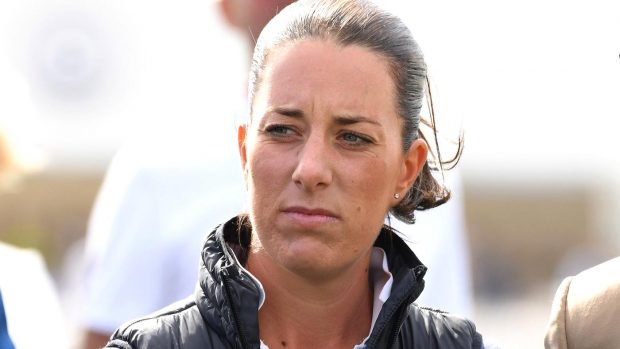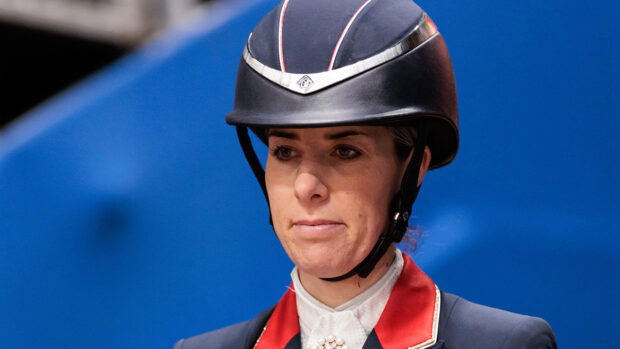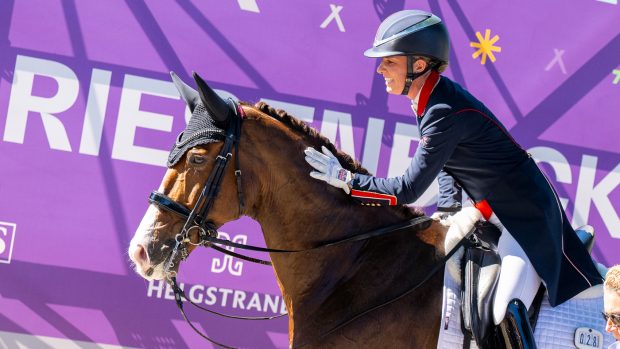Even without her superstar partner Valegro, Charlotte Dujardin wowed fans at the Rolex Central Park Horse Show in New York on Sunday (27 September), when she gave a masterclass aboard Evi Strasser's Renaissance Tyme demonstrating her training techniques. Nancy Jaffer picks out seven takeaway tips
Dressed informally all in black for her masterclass, Charlotte Dujardin went through the building blocks of her training routine aboard her high-energy mount Renaissance Tyme, owned by Canadian Evi Strasser.
1. Warming up: get the horse as relaxed and supple as possible
Charlotte started the masterclass by explaining the importance of a proper warm-up, beginning by stretching the horse, making him relaxed, supple and as loose as possible before getting into serious work. “What I’m trying to do is get the base to be as long, low and stretched as possible, so that behind the saddle, he lifts his back and these muscles start to move and be used in the right way,” she said.
2. High standards: correct your mistakes
Charlotte emphasised that everything must be done right from the first step, and corrected properly and promptly. A rider needs discipline, being strong enough “not to let bad habits happen”.
“If you make bad transitions at home, just because you’re lazy or not really thinking about it, you’re going to make bad transitions in the competition arena,” she said.
“When someone says about their horse’s performance, ‘Oh well, he did this or he did that’, that’s because you allowed him in the first place to make all those mistakes.”
Continued below…
12 facts you may not know about Charlotte Dujardin's record-breaking horse

12 things you might not know about Valegro
3. Use the arena to your advantage
Charlotte used the arena walls to train Renaissance Tyme to do his flying changes straight, as he had a tendency to be crooked. To correct that, she never did changes across the diagonal where he wouldn’t have the walls to guide him.
She emphasised the importance of the short side of the ring and the corners, which should be used to get the horse back and set up for the next movement.
“If I ride a bad corner, I’m going to ride a bad movement,” she said.
4. Work on both sides of the horse
Charlotte stressed that it is important to work on the horse’s weak side, trying to get it to feel the same as his strong side, so he’s even on both sides. Those who just want to work on the easy side are “cheating”, she said.
5. Help the horse out
“It’s important you work with the horse, not against it,” said Charlotte, achieving harmony in a short time during the masterclass with the horse who obviously was not an easy ride.
Among the exercises she demonstrated were a suppling leg yield in the canter, and practising the piaffe going forward, rather than keeping him on the spot, which is “a tremendous amount of strain”. A horse trained that way won’t last, she warned. By allowing the horse to train the piaffe forward he can “see a way out,” and it’s a method for obtaining a good transition into passage.
6. Look for a quality walk and canter in a potential horse
Easing the tension in the horse, Charlotte rode every part of the walk, guiding him in slow, deliberate steps until she had him where she wanted him, then let him stride out. She noted that the extended and collected walk movements have double co-efficients in a test, and those are big marks “to lose because of tension”.
The quality of the walk and the canter are what she looks for when considering buying a horse, because they can’t be fixed the way the trot can “by teaching suspension”.
To bring the horse’s back up in self-carriage, she touches him with her legs and by doing a half-halt with the rein, she can “start to create lift and suspension. Then I ride forward and try to keep the suspension in the trot”.
She wants to make sure the horse “carries his own head and neck; it’s not my job.”
7. And finally… reward a horse during training
“When he does something good, give him a walk and a breather,” said Charlotte.
“In the big picture, as a rider, you have to be able to feel how much work the horse can take. Don’t go until he gets tired and isn’t working with you,” she said. “It’s not about how much you do; it’s about what you do.”






